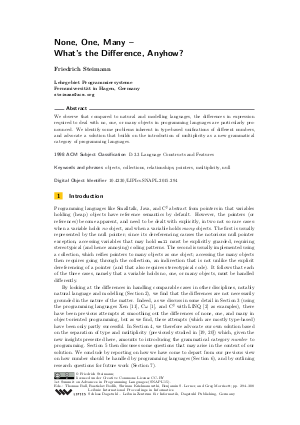None, One, Many - What's the Difference, Anyhow?
Author Friedrich Steimann
-
Part of:
Volume:
1st Summit on Advances in Programming Languages (SNAPL 2015)
Part of: Series: Leibniz International Proceedings in Informatics (LIPIcs)
Part of: Conference: Summit on Advances in Programming Languages (SNAPL) - License:
 Creative Commons Attribution 3.0 Unported license
Creative Commons Attribution 3.0 Unported license
- Publication Date: 2015-04-30
File

PDF
LIPIcs.SNAPL.2015.294.pdf
- Filesize: 0.49 MB
- 15 pages
Document Identifiers
Subject Classification
Keywords
- objects
- collections
- relationships
- pointers
- multiplicity
- null
Metrics
- Access Statistics
-
Total Accesses (updated on a weekly basis)
0Document
0Metadata
Abstract
We observe that compared to natural and modelling languages, the differences in expression required to deal with no, one, or many objects in programming languages are particularly pronounced. We identify some problems inherent in type-based unifications of different numbers, and advocate a solution that builds on the introduction of multiplicity as a new grammatical category of programming languages.
Cite As Get BibTex
Friedrich Steimann. None, One, Many - What's the Difference, Anyhow?. In 1st Summit on Advances in Programming Languages (SNAPL 2015). Leibniz International Proceedings in Informatics (LIPIcs), Volume 32, pp. 294-308, Schloss Dagstuhl – Leibniz-Zentrum für Informatik (2015)
https://doi.org/10.4230/LIPIcs.SNAPL.2015.294
BibTex
@InProceedings{steimann:LIPIcs.SNAPL.2015.294,
author = {Steimann, Friedrich},
title = {{None, One, Many - What's the Difference, Anyhow?}},
booktitle = {1st Summit on Advances in Programming Languages (SNAPL 2015)},
pages = {294--308},
series = {Leibniz International Proceedings in Informatics (LIPIcs)},
ISBN = {978-3-939897-80-4},
ISSN = {1868-8969},
year = {2015},
volume = {32},
editor = {Ball, Thomas and Bodík, Rastislav and Krishnamurthi, Shriram and Lerner, Benjamin S. and Morriset, Greg},
publisher = {Schloss Dagstuhl -- Leibniz-Zentrum f{\"u}r Informatik},
address = {Dagstuhl, Germany},
URL = {https://drops.dagstuhl.de/entities/document/10.4230/LIPIcs.SNAPL.2015.294},
URN = {urn:nbn:de:0030-drops-50329},
doi = {10.4230/LIPIcs.SNAPL.2015.294},
annote = {Keywords: objects, collections, relationships, pointers, multiplicity, null}
}
Author Details
References
-
Gavin M. Bierman, Erik Meijer, and Wolfram Schulte. The essence of data access in Cω. In Andrew P. Black, editor, ECOOP 2005 - Object-Oriented Programming, 19th European Conference, Glasgow, UK, July 25-29, 2005, Proceedings, volume 3586 of Lecture Notes in Computer Science, pages 287-311. Springer, 2005.

-
Gavin M. Bierman, Erik Meijer, and Mads Torgersen. Lost in translation: formalizing proposed extensions to C^♯. In Richard P. Gabriel, David F. Bacon, Cristina Videira Lopes, and Guy L. Steele Jr., editors, Proceedings of the 22nd Annual ACM SIGPLAN Conference on Object-Oriented Programming, Systems, Languages, and Applications, OOPSLA 2007, October 21-25, 2007, Montreal, Quebec, Canada, pages 479-498. ACM, 2007.

-
Kim B. Bruce, Luca Cardelli, Giuseppe Castagna, Jonathan Eifrig, Scott F. Smith, Valery Trifonov, Gary T. Leavens, and Benjamin C. Pierce. On binary methods. TAPOS, 1(3):221-242, 1995.

-
Peter P. Chen. The entity-relationship model - Toward a unified view of data. ACM Trans. Database Syst., 1(1):9-36, 1976.

-
Umberto Eco. The Search for the Perfect Language. Wiley-Blackwell, 1997.

-
Andrew Eisenberg and Jim Melton. SQL: 1999, formerly known as SQL 3. SIGMOD Record, 28(1):131-138, 1999.

-
Adele Goldberg and David Robson. Smalltalk-80: The Language and Its Implementation. Addison-Wesley, 1983.

-
Daniel Jackson. Software Abstractions - Logic, Language, and Analysis. MIT Press, 2006.

-
Roman Knöll, Vaidas Gasiunas, and Mira Mezini. Naturalistic types. In Robert Hirschfeld and Eelco Visser, editors, ACM Symposium on New Ideas in Programming and Reflections on Software, Onward! 2011, part of SPLASH'11, Portland, OR, USA, October 22-27, 2011, pages 33-48. ACM, 2011.

-
Adrian Kuhn, David Erni, and Marcus Denker. Empowering collections with swarm behavior. CoRR, abs/1007.0159, 2010.

-
Erik Meijer, Wolfram Schulte, and Gavin M. Bierman. Unifying tables, objects and documents. In Proceedings of Declarative Programming in the Context of OO Languages (DP-COOL 2003), August 2003.

- OMG (Object Management Group). Unified Modeling Language 2.4.1. Specification, OMG (Object Management Group), 2011. URL: http://www.omg.org/spec/UML/2.4.1/.
- OMG (Object Management Group). Object Constraint Language 2.4. Specification, OMG (Object Management Group), 1 2012. URL: http://www.omg.org/spec/OCL/.
-
Marco Servetto, Julian Mackay, Alex Potanin, and James Noble. The billion-dollar fix - safe modular circular initialisation with placeholders and placeholder types. In Giuseppe Castagna, editor, ECOOP 2013 - Object-Oriented Programming - 27th European Conference, Montpellier, France, July 1-5, 2013. Proceedings, volume 7920 of Lecture Notes in Computer Science, pages 205-229. Springer, 2013.

-
Justin Slepak, Olin Shivers, and Panagiotis Manolios. An array-oriented language with static rank polymorphism. In Zhong Shao, editor, Programming Languages and Systems - 23rd European Symposium on Programming, ESOP 2014, Held as Part of the European Joint Conferences on Theory and Practice of Software, ETAPS 2014, Grenoble, France, April 5-13, 2014, Proceedings, volume 8410 of Lecture Notes in Computer Science, pages 27-46. Springer, 2014.

-
Friedrich Steimann. On the representation of roles in object-oriented and conceptual modelling. Data Knowl. Eng., 35(1):83-106, 2000.

-
Friedrich Steimann. Role = interface - A merger of concepts. Journal of Object-Oriented Programming, 14:23-32, 2001.

-
Friedrich Steimann. Role + counter role = relationship + collaboration. In Stephen Nelson and Stephanie Balzer, editors, RAOOL'08: Proceedings of the Workshop on Relationships and Associations in Object-Oriented Languages, co-located with OOPSLA 2008, Nashville, TN, USA, 2008.

-
Friedrich Steimann. Content over container: Object-oriented programming with multiplicities. In Antony L. Hosking, Patrick Th. Eugster, and Robert Hirschfeld, editors, ACM Symposium on New Ideas in Programming and Reflections on Software, Onward! 2013, part of SPLASH'13, Indianapolis, IN, USA, October 26-31, 2013, pages 173-186. ACM, 2013.

-
Friedrich Steimann, Jesper Öqvist, and Görel Hedin. Multitudes of objects: First implementation and case study for Java. Journal of Object Technology, 13(5):1: 1-33, 2014.

-
Toon Verwaest, Camillo Bruni, Mircea Lungu, and Oscar Nierstrasz. Flexible object layouts: enabling lightweight language extensions by intercepting slot access. In Cristina Videira Lopes and Kathleen Fisher, editors, Proceedings of the 26th Annual ACM SIGPLAN Conference on Object-Oriented Programming, Systems, Languages, and Applications, OOPSLA 2011, part of SPLASH 2011, Portland, OR, USA, October 22-27, 2011, pages 959-972. ACM, 2011.

-
Bobby Woolf. Null object. In Robert C. Martin, Dirk Riehle, and Frank Buschmann, editors, Pattern Languages of Program Design 3, pages 5-18. Addison-Wesley Longman Publishing Co., Inc., Boston, MA, USA, 1997.

